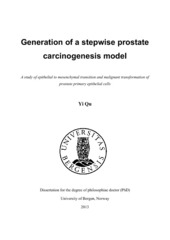| dc.contributor.author | Qu, Yi | en_US |
| dc.date.accessioned | 2013-06-23T12:08:49Z | |
| dc.date.available | 2013-06-23T12:08:49Z | |
| dc.date.issued | 2013-05-29 | eng |
| dc.identifier.isbn | 978-82-308-2295-1 | en_US |
| dc.identifier.uri | https://hdl.handle.net/1956/6716 | |
| dc.description.abstract | Despite progress in recent years, prostate cancer continues to be one of the most prevalent causes of cancer-related mortality and morbidity in men in Western countries. A major clinical challenge of prostate cancer therapy is the current inability to readily distinguish between tumors with low and high aggressivity concerning ability to further invasion and metastasis. Understanding the mechanism of tumor initiation and progression is critical in diagnosis and treatment of prostate cancer patients. However, optimal prostate cancer initiation and progression models have been lacking. Previous malignantly transformed prostate cells were mainly established by exposure of benign prostate cells to strong external carcinogens or introduction of oncogenes or viral elements. These kinds of prostate cancer models are not optimal for representative studies on prostate carcinogenesis in vivo. Therefore, it is extremely valuable to establish a human prostate carcinogenesis model based on more physiological conditions. The present translational study mainly focuses on the establishment of a stepwise prostate carcinogenesis model based upon human primary basal epithelial EP156T cells that were derived from prostate benign tissues in a patient following radical prostatectomy for prostate cancer. Paper I established an epithelial to mesenchymal transition (EMT) model. EP156T cells were adapted in long-term confluent culture, and cells with reduced contact inhibition appeared and had undergone EMT without malignant features, the new cells were named EPT1 cells. In Paper II EPT2-D5 cells were generated based on focus formation in confluent EPT1 cell monolayers and cloning in soft agar. EPT2-D5 cells had acquired in vitro malignant features such as focus formation, colony formation in soft agar, higher resistance to apoptosis and independence of exogenous growth factors. However, EPT2-D5 cells failed to form xenograft tumors in mice. Paper III explored the roles of microRNAs (miRNAs) in EMT using the EMT model established in Paper I. Two miRNAs (miR-203 and miR- 182) were found to induce both mesenchymal to epithelial transition (MET) and selfsufficiency of growth signals via repressing SNAI2 in prostate cells. Paper IV reported the complete malignant transformation of prostate benign epithelial cells. EPT2-D5 cells were adapted in protein free medium and generated prostate spheres that efficiently initiated subcutaneous tumors and subsequent large primary prostate tumors and metastasis in nude mice. Cells isolated from subcutaneous tumors, primary tumors and metastases were named EPT3, EPT3-PT1 and EPT3-M1 cells, respectively. Furthermore, a ROS/IL6/STAT3 cascade was found critical in the EPT3 tumor initiation and progression. The present prostate stepwise carcinogenesis model is unique because all the cells were obtained under physiological conditions and cells at different stages harbor distinct phenotypes that are commonly utilized as markers for tumor initiation and metastasis in vitro and in vivo. An exact passage record has been secured, and the EP156T, EPT1, EPT2 and different EPT3 cells of the model can be propagated indefinitely as seemingly rather stable cell types in subconfluent cultures. The identification of the ROS/IL6/STAT3 cascade in EPT3 tumor initiation and progression provides a good opportunity for therapeutic development of anti-cancer drug targeting of the ROS/ IL6/STAT3 pathway. | en_US |
| dc.language.iso | eng | eng |
| dc.publisher | The University of Bergen | eng |
| dc.relation.haspart | Paper I: Ke XS, Qu Y, Goldfinger N, Rostad K, Hovland R, Akslen LA, Rotter V, Øyan AM, Kalland KH. (2008) Epithelial to mesenchymal transition of a primary prostate cell line with switches of cell adhesion modules but without malignant transformation. PLoS ONE 3(10):e3368, October 2008. The article is available at: <a href="http://hdl.handle.net/1956/6715" target="blank">http://hdl.handle.net/1956/6715</a> | en_US |
| dc.relation.haspart | Paper II: Ke XS, Li WC, Hovland R, Qu Y, Liu RH, McCormack E, Thorsen F, Olsen JR, Molven A, Kogan-Sakin I, Rotter V, Akslen LA, Oyan AM, Kalland KH. (2011) Reprogramming of cell junction modules during stepwise epithelial to mesenchymal transition and accumulation of malignant features in vitro in a prostate cell model. Experimental Cell Research 317(2): 234-247, January 2011. Full text not available in BORA due to publisher restrictions. The article is available at: <a href="http://dx.doi.org/10.1016/j.yexcr.2010.10.009" target="blank"> http://dx.doi.org/10.1016/j.yexcr.2010.10.009</a> | en_US |
| dc.relation.haspart | Paper III: Qu Y, Li WC, Hellem MR, Rostad K, Popa M, McCormack E, Oyan AM, Kalland KH, Ke XS. MiR-182 and miR-203 induce mesenchymal to epithelial transition and selfsufficiency of growth signals via repressing SNAI2 in prostate cells. International Journal of Cancer 133(3): 544–555, August 2013. Full text not available in BORA due to publisher restrictions. The article is available at: <a href="http://dx.doi.org/10.1002/ijc.28056" target="blank"> http://dx.doi.org/10.1002/ijc.28056</a> | en_US |
| dc.relation.haspart | Paper IV: Qu Y, Oyan AM, Liu RH, Hua YP, Jigang Zhang, Hovlan R, Popa M, , Brokstad KA, Molven A, Liu XJ, Simon R, Lin B Zhang WD, McCormack E, Kalland KH, Ke XS. Generation of prostate tumor-initiating cells is associated with elevation of reactive oxygen species and IL6/STAT3 signaling. Full text not available in BORA. | en_US |
| dc.title | Generation of a stepwise prostate carcinogenesis model. A study of epithelial to mesenchymal transition and malignant transformation of prostate primary epithelial cells | en_US |
| dc.type | Doctoral thesis | |
| dc.rights.holder | Copyright the author. All rights reserved | |
